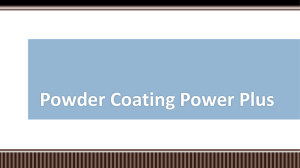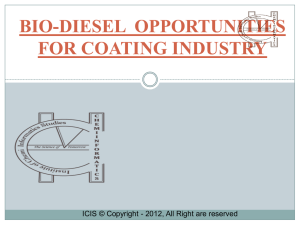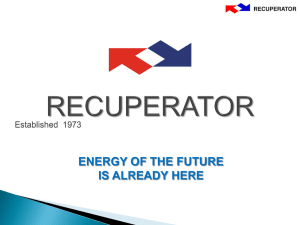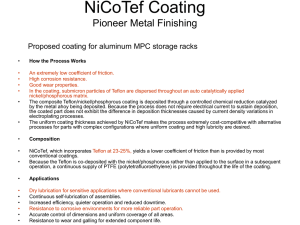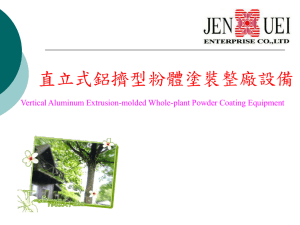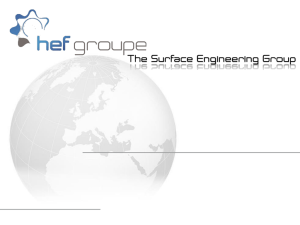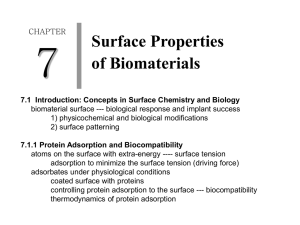Polymeric Coatings - Loy Research Group
advertisement
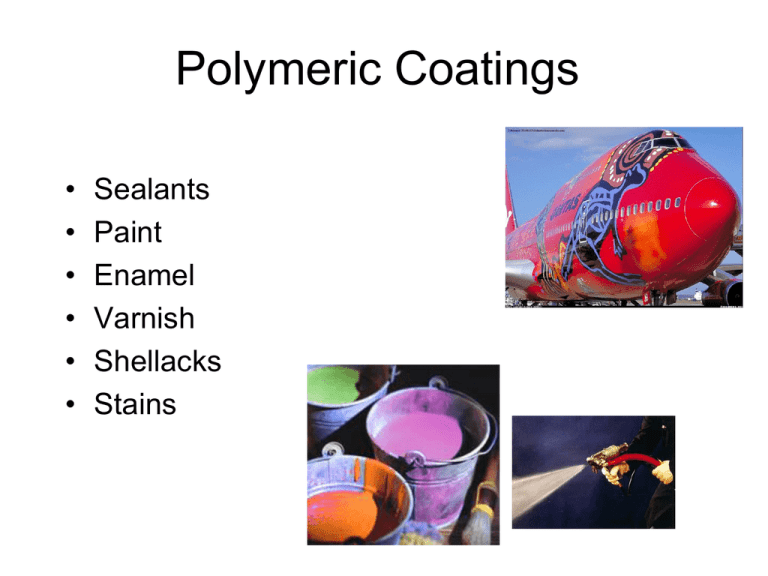
Polymeric Coatings • • • • • • Sealants Paint Enamel Varnish Shellacks Stains Enamels • Not the same as vitreous or porcelain enamel-a glass powder fired in a furnace • In paint, it refers to a higher quality paint Sealants • Barrier material (protective coating) • Generally weaker than adhesive examples: -Asphalt/coal tar based seal coatings -Anerobic acrylic sealants -silicone coatings on membranes -roof sealants What are roofing sealants? Filled and highly pigmented elastomers • EPDM (ethylene-propylene-diene monomer) rubber (e.g. liquid rubber) • Acrylic elastomers • Silicones (not very good-often adhesion issues) • Polyurethane Methods for applying polymeric Coatings • • • • • • Powder Spray coatings Electrocoating Fluidized Bed Dip coating Spray coating Spin coating Coatings Market •50+ billion USD worldwide, divided into 3 main segments •Architectural: Paints, varnishes, and lacquers for direct application to interior or exterior surfaces of buildings – ~50% of total market, but lowest profit margin – Generally air-dried – Sherwin-Williams, Benjamin Moore, ICI Paints •OEM/Product: Applied to equipment in a manufacture process – Appliances, cars, industrial machinery, furniture, … – ~35% of total market, higher profits – Baked, radiation-cured, electrostatic-spray – Automotive: PPG, DuPont, BASF •Specialty Market: Everything else – Auto refinish, traffic marking, … – ~15%, usually high-value – Air or force dried – PPG, DuPont, Akzo Nobel, … OEM = original equipment manufacturer High viscosity coating http://money.howstuffworks.com/krispy-kreme4.htm What is in a can of paint? Pigments 45% Additives 4% Solvent 16% Binder (polymer) 32% Water based paints may have considerably more liquid carrier 1 pascal second = 10 poise = 1,000 millipascal second 1 centipoise = 1 millipascal second Measuring viscosities 10-100,000 cP Requires standards Measuring viscosities Zahn Cup Newtonian Fluids Newtonian flow paints would also flow away from sharp corners and edges and give significant sagging or curtaining problems when applied. MATERIAL APPROXIMATE VISCOSITY (in centipoise) Water @ 70 F 1 to 5 Blood or Kerosene 10 Anti-Freeze or Ethylene Glycol 15 Motor Oil SAE10 or Mazola Corn Oil 50 to 100 Motor Oil SAE30 or Maple Syrup 150 to 200 Motor Oil SAE40 or Castor Oil 250 to 500 Motor Oil SAE60 or Glycerin 1,000 to 2,000 Karo Corn Syrup or Honey 2,000 to 3,000 Blackstrap Molasses 5,000 to 10,000 Hershey Chocolate Syrup 10,000 to 25,000 Heinz Ketchup or French's Mustard 50,000 to 70,000 Tomato Paste or Peanut Butter 150,000 to 250,000 Crisco Shortening or Lard 1,000,000 to 2,000,000 Caulking Compound 5,000,000 to 10,000,000 Window Putty 100,000,000 Non-Newtonian Liquids Non-Newtonian Liquids: (Time Independent) Pseudo-Plastic molten thermoplastics polymer solutions such as polyethylene oxide in water some paints. shampoo ketchup Shear Thickening (Time Independent) Dilatant Solids dispersed in liquid Corn starch, clay slurries, wet sand (quick sand) surfactant solutions, peanut butter, filled composites Plastic Fluids: have a yield stress threshold No flow until a critical stress is reacted. Toothpaste Drilling mud Mayonnaise Some paints Grease Excellent settling & separation resistance in can Too high yield point: problems applying & orange peel Too low: sagging & curtaining Time dependent Non-Newtonian Viscosity The viscosity of the fluid is dependent on temperature, shear rate and time. Depending on how viscosity changes with time the flow behaviour is characterised as:・Thixotropic (time thinning, i.e. viscosity decreases with time) yoghurt, paint ・Rheopetic (time thickening, i.e. viscosity increases with time)-gypsum paste Thixotropic fluids are quite common in chemical as well as in food industry. Rheopectic fluids are very rare. Polymeric Coatings • Coatings are materials that are applied to a surface which form a continuous film in order to beautify and/or protect the surface. • • • • • • Paint: Pigmented surface coating Varnish: Coating that lacks a pigment Lacquer: Thermoplastic solution paints or varnishes, term also used for all clear wood finishes Enamel: Hard, thermosetting paints Paint:Interesting Facts A jumbo jet needs 2 tons of paint. The world's shipping fleet would produce an extra 70 million tons of greenhouse gasses and nearly 6 million tons of acidrain-producing sulfur dioxide if ships were not treated with anti-fouling paints Paint Markets Contents of Paint • Pigment – Provides color and durability – Also improves the strength of the paint • Binder – Holds the pigment in liquid form – When applied it then gives the paint the ability to adhere to the surface. • Solvent – Effectively thins the paint – It carries the pigment and binder – Used to regulate how much a paint flows – Called a “thinner” when used with lacquer – Called a “reducer” when used with enamel Binders: Polymers • Thermosets – – – – – Alkyds Epoxies Urethanes Formaldehyde resins Alkyds (classic oil paint) • Thermoplastics (latexes) – Acrylics + other vinyl monomers – Vinyls: vinylacetate copolymers with acrylics, vinyl chloride, styrene AFM of latex General Coating Formulations Method Polymer Solids M.W. Evaporation high Polymer structure (i) low, linear 10-35% solution (ii) medium 40-70% emulsion Dry rate Min. dry (no heat) temp. fast Handling/ Storage no practical good limit (solutions) Examples nitrocellulose other lacquers; some emulsion paints Chemical low reaction between paint and air medium to high, 35100% crosslinked slowvery slow moderate in cold weather cans must be well sealed decorative paints some stoving enamels; Chemical reaction between paint ingredients medium to high 30-100% crosslinked fairly fast two-pack or short shelf life, unless stoving or radiation curing type industrial stoving finishes; acidcatalysed polyurethane and polyester wood finishes low or very low varies; 10-15°C Desired Rheology of Coatings • • • • Coating viscosity requirements change on passing from the application to drying stages of the process. h time • Application – brushing, rolling, spraying processes generate high shear, and favour low viscosity formulations – chain orientation and surface imperfections (brush strokes) must be relieved by flow. • Film Formation - Drying – sagging during the drying process must be countered by low-shear viscosity. • Final Coating Properties – permanent coating requires near infinite viscosity, through high molecular weight (lacquers) or crosslinking (enamels). Solvent-Related Surface Defects Solvent popping results from rapid solvent evaporation and an inability of the coating to flow. Orange peel patterns result from high film viscosity and/or surface tension gradient induced flow. Coating Formulations: Polymeric Binders • • • • • Coatings employ amorphous polymers almost exclusively. Glass transition influences mechanical properties such as flexibility, hardness, etc. • Impact resistance is often • • desired for hard topcoat applications. Consideration of UV, thermal, oxidative stability depends on application (primer, topcoat). Filler/pigment acceptance, surface energy, miscibility in solvents/plasticizers. Binder: alkyd resin Polyester of: • Polyol (glycerol) • Phtalic acid • Fatty acid Alkyd resin Linseed Sunflower O OH Linolenic acid O OH Linoleic acid Tough Coat® Acrylic Alkyd Enamels Thermosetting Binders: Epoxy and Polyurethane Resins • Epoxy resins are two-component paints formulated from epoxide functionalized monomer and (usually) amine hardeners. O O CH2O + OCH2 H2N NH2 OH O CH2O OCH2 NH NH2 • Reaction of diisocyanates with diols generates polyurethane coatings whose structure/properties can be varied widely. • Polyurethanes afford superiour abrasion and chemical resistance, as well as a fast, low-temperature cure. Polyurethanes • One part polyurethane • Moisture cured polyurethane • Acrylic polyols-aliphatic linear isocyanate two part polyurethanes • Polyester polyols-aliphatic isocyanate two part polyurethane Low High component 1 component 2 O n O OH n-m m OH O NH R NH OCN R NCO O OH m O n-m n-m n O O O OMe O OCN R NCO O MeO O HO O HN R N H O O O O O Thermosetting Binders: Combination • Copolymerization of an acid-functionalized acrylic resin and an epoxy resin yields a crosslinked, block copolymer coating. COOH 2 + CH2 n H Acid functionalized acrylic resin OH O CH2 O C CH2 CH2 CH Resin CH CH2 O O Epoxy resin OH CH Resin CH CH2 O C O CH Anti-corrosive epoxy CH2 CH n n Epoxy Paints Epoxy coating Thermosetting Binders: Cured Polyesters and Acrylics • Unsaturated polyesters and acrylic resins of low molecular weight can be polymerized by free radical addition chemistry to generate a stable, crosslinked film. • Consider a resin comprised of 1,2-propylene glycol, phthalic anhydride and maleic anhydride. • Free radical polymerization initiated by an organic peroxide generates a networked structure of high molecular weight by addition through unsaturation in the polymer backbone. Thermosetting Binders: Oxidative Drying Alkyds • While alkyds can be classified as polyesters, the term is reserved for oil-based finishes. • Oils are first transformed into monoglycerides: • • • • • Film formation results from condensation polymerization with diacid as well as oxidative cure. Thermosetting Binders: Oxidative Drying Oils • • • • • Coatings containing oil-based films are no longer used as finishes due to poor gloss, soft films and inferiour water resistance. – Oils are frequently used in conjunction with other resins to modify drying properties and film structure. O CH2 O C C16HnCH3 O CH O C C16HnCH3 O CH2 O C C16HnCH3 Natural oils are extracted from linseed, soya bean, coconut, etc. Unsaturated oils are valued for their relatively rapid oxidative curing. n=32,30,28,26 • • • Curing occurs through hydroperoxide formation, followed by alkyl radical combination. O2 OOH O OH + ROH Water-based formulations: Emulsions • Emulsion formulations were developed for environmental reasons and for the delivery of very high molecular weight binders. – Water is the continuous phase, which results in a very low viscosity coating. – Thixotropic agents are required to raise the zero-shear viscosity of the formulation. •Most emulsion paints contain some solvent/plasiticizer to modify the Tg of the polymer. –Film formation requires coalescence of polymer particles, which cannot occur below Tg. –Organic solvents assist with film formation, and evaporate to leave a solid coating. –Alternately, a plasticizing agent is used to maintain a flexible film throughout the object’s lifetime. Thermoplastic Binders: Emulsions • Household emulsion paints are usually comprised of • poly(vinyl acetate-co-ethyl acrylate) or poly(acrylate-co-acrylic acid) resins – pigment is dispersed in the continuous aqueous phase with suitable surfactants and water-soluble thickener. – plasticizers or volatile solvents are used to lower Tg such that particle coalescence can function – High-gloss latex paints cannot be manufactured, as surface uniformity is generally poor – Residual surfactant can lead to inferior water stability of latex derived films. AFM of latex n O Me O O OEt n HO O O OEt There once was a theorist from France who wondered how molecules dance. “They’re like snakes,” he observed, “As they follow a curve, the large ones Can hardly advance.” D ~ M -2 de Gennes P.G. de Gennes Scaling Concepts in Polymer Physics Cornell University Press, 1979 Thermoplastic Binders: Lacquers • Lacquers harden quickly at all practical temperatures, are supplied in one pack and do not suffer from shelf or pot life problems. – comprised of hard linear polymers in solution • Cellulose nitrate, a derivative of the natural product cellulose is prepared with varying degrees of modification for different grades: • • O O • Solubility in esters, ketones ONO2 O2NO and alcohols depends on O OH • n extent of cellulose functionalization • Acrylic lacquers are comprised of homo or copolymers of acrylates, properties depending on polymer composition distribution: • Poly(methyl methacrylate) • • n MeO O provides hardness and UV stability. Plasticizers and • copolymerization alters Tg. Coating Formulations: Solvent Selection Criteria • Solvating Capacity: Miscibility of polymer/solvent systems are dictated by thermodynamics, as approximated by solubility parameters and hydrogen bonding groupings. • Viscosity: Influenced by solvating capacity, but also a function of the viscosity of pure solvent and additives. • Volatility: Rate of solvent evaporation influences drying time as well as film aesthetic qualities. Decisions often based upon boiling point/range. • Toxicity and smell. • Cost. Evolution of Solvent-borne Acrylic Coatings 1950’s 1960’s Lacquers 75 % solvent 25 % solids 106 Mw 105 104 103 1970’s 1980’s High-Solids Enamels 50 % solvent 50 % solids 1990’s 2000’s Super-Solids Enamels 25 % solvent 75 % solids Coating Formulations: Extenders and others • Extenders provide no colour to a film, but their use is an inexpensive method of improving adhesion, ease of sanding, film strength and opacity. – Calcium carbonate (whitewash) – Aluminum silicate (clay) – Magnesium silicate (talc) – Barium sulphate (barytes) – Silica • Viscosity Modifiers – silicates, clays, poorly soluble resins Dispersion Aids – aid in pigment dispersion - chosen on a case-by-case basis Interfacial Tension Modifiers – non-ionic surfactants, soaps Biocides – insecticides, fungicides • • • Coating Formulations: Pigments Pigments are selected on the basis of: Particle size Tinting strength Thermal Stability • Property Particle shape Lightfastness Chemical Reactivity Preference Refractive Index Hiding Power Density (cost) Reasons •(1) Brilliance and • clarity of hue Organic The most attractive, cleanest colours are obtained with organic pigments. •(2) White and • black paints Inorganic The purest white pigment is TiO2 and the most jet black, carbon. •(3) Non-bleeding • • • Inorganic Inorganic compounds have negligible solubilities in organic solvents. Some organics are very insoluble. •(4) Lightfastness • Inorganic Inorganic compounds are generally more stable to UV than organics. •(5) Heat stability • Inorganic Very few organic compounds are stable above 300°C. Aesthetic Properties of Dried Film Coatings • Opacity – Extent of substrate coverage, as determined by pigments, extenders and other occlusions in the film. – Dependent on refractive index of fillers relative to the polymeric binder. • Surface Finish – Gloss is a function of surface irregularity, as determined by the film formation process and dispersion of pigments/fillers. • Color – Inorganic and organic colourants that are soluble or dispersed in the film (may or may not provide opacity). Thickeners are large water-soluble polymers added to a paint to increase its viscosity. Viscosity can be defined as the resistance of a liquid to flow. This property is important for a paint for several reasons: so the paint can flow out of the can so the paint can be applied to a substrate (glass, wood, steel, etc) using a paint brush or a roller. so the paint does not splatter or drip on the user so no brush marks can be seen to prevent settling of the paint in the can during storage so that a "good" film can be formedlm can be formed Engineering Properties of Dried Film Coatings • • • • • • • Properties: Hardness Impact (& Chip) Resistance Flexibility Abrasion Resistance Solvent Resistance Adhesion • • • • • • • Tests: Indentation, Scratch (Pencil) Drop tests, Gravelometer Elongation, Bend Falling sand test MEK (methylethylketone) double rub Scraping, Crosscut Adhesion Issues: • Properties are a complex function of many factors: Tg, MW, crosslink density, pigmentation, static stress-strain behaviour, transient (creep) behavior • What do you test? Free films? Coating with substrate? • Weatherability and UV resistance – How does it hold up over time? Coating processes: Coil Coating •Coat sheet metal from coils before shaping • Calendar or knife delivery • Also electrocoat & spray Coil Coating Spraying (charged particles) Curing (Infrared oven) Powder Coating • • • • • • • High-gloss finish Uniform coat Durable coat Color selection Pollution-free Recycle powder Short cure times cold substrate electrical adhesion substrate heated polyester melts TGIC diffuses crosslinked solid film Powders used in Spray Coating Epoxies-More durable, but more light sensitive (chalking) HO HO O O H N NH N H N O O OH OH NH N N H N O OH O Polyesters-More light stable O O O O O O O Polymer + Binder HO Me Me O O O O O O O Me Pigment + Filler + Antioxidant Applications: OEM Preparing the Coating Powder O HO OH HO2C O H CO2H H 240 °C n O O O OH O O O O SnCl4 OH O O n O O O O O O O SnCl4 n O O O 240°C CO2H 2 HO2C HO2C CO2H Polyester milled into powder O O N N O N Polyester powder O O O tri-glycidyl-iso-cyanurate powder = Paint O The crosslinking during the cure O N O N O O O n O N O O O HO2C tri-glycidyl-iso-cyanurate powder Polyester milled into powder O O O O O O O n O O O O O OH O O O O O CO2H O O O O O N O HO O O N O O O OH N O O HO O O O O O N O O O HO O O O O N N O O O OH O O O Powder Coating versus Paint no solvent (toxic) solvent recycles unused coating overspray wasted single layer sufficient several layers required conflicting flow requirements viscosity adjusted separately now dominates for coating of parts Thermal Spray Rod Wire Powder Heat Source Feedstock Materials Acceleration Impact Supersonic flow shock diamonds Powder injector Combustor Cooling water in Oxygen Fuel Cooling water out Coating Substrate Splatting & Cooling Powder coating wood 90-120 °C IR heating There are 4 key stages in the manufacture process of powder coatings: 1. Formulation The formulation of powder coatings involves the use of 4 key raw material types: resins, pigments, curing agents and additives. Resins provide strength, durability and adhesion; pigments add color; curing agents ensure that the resins bond to the substrate and harden, and additives give further coating properties such as enhanced application, improved flow, etc. 2. Premix Once a product has been formulated, raw materials are carefully weighed and measured. These raw materials are then blended together, either by mixing or tumbling, to ensure a consistent dispersion of raw materials throughout the mixture. 3. Extrusion The mixed raw materials are then fed into an extruder. The extruder applies pressure and heat to melt the resins and thoroughly incorporate the pigments, curing agents and other ingredients into a homogenous substance. The extrudate is then cooled and chipped. 4. Grinding Once the extrudate has been cooled and chipped, it is ready to be ground into a fine powder. This powder is then sieved and classified to ensure an even particle size distribution. Particles that are under 10 micrometers or over 120 micrometers can cause application problems and are restricted by the sieving and classification process.ication process. Epoxy powder coated podium Powder coatings have several significant advantages over solvent-based liquid paints: No solvents - Liquid paints can contain up to 70% solvent. Powder coatings contain no solvents, and therefore eliminate solvent release into the environment. Recyclable - Oversprayed powder can be reclaimed and reused, allowing up to 95% material utilization, reducing waste Fewer variables in film properties - The more uniform properties of powders and the elimination of thinners and solvent balancing lead to a more consistent paint film in just one coat.n just o Electrocoating or E-coat The Electrocoating Process... • Precipitation of paint particles onto a metal substrate • Highly efficient and automated process • Paint deposition is regulated by voltage • Coating can be either anodic or cathodic • Thermoset curing PPG E-Coat: Anodic Coatings Anode has a positive charge that attracts the negatively charged polymers Epoxies (cure >80 °C) Acrylics (cure > 150 °C) Acid-modified polybutadiene Butylated-formaldehyde-melamine (150 °C) O O CO2H O HO2C KOH O E-Coat: Cathodic Coatings Cathode has a negative charge that attracts the positively charged polymers Epoxies (cure >190 °C) Acrylics (cure > 190 °C) • Corrosion resistant cationic epoxies • High edge coverage for sharp objects • Solvent free anodic products • Cathodic acrylics with corrosion resistance and excellent exterior durability • Near 100% transfer efficiency operation • Two-coat Electrocoat for severe environments • Heavy-Metal free formulations • HAPs free formulations • Electrodepositable Photoresists Agriculture Equipment, Appliance, Automotive, Fasteners, Metal Office Furniture, Printed Circuit Boards, Structural Steel, Wheels, Railway PPG Automobile Painting Fluidized Bed Coating • • • • • Polymer powder in air generated fluidized bed Normal or electrostatic FB coater PVC, polyethylene copolymers Protective, decorative coatings Safety glass bottles Heat part, then dip into FB coater 100 °C for PE copolymer Fluidized Bed Coatings A part recently taken out of a fluid bed coater with about 10 mils of functionalized polyethylene applied. Photo courtesy of Wright Coating Company, Kalamazoo, MI. Dip Coating PVC CVD: Parylene Coating 1947, Michael Mojzesz Swarc http://www.scscookson.com/parylene/properties.cfm CVD Polymerization Gas phase Polymerizes on contact Conformal coatings Pinhole free Preserving artifacts (paper) Microelectronics Medical devices Polyxylylene Parylene C The most widely used dimer, providing a useful combination of properties, plus a very low permeability to moisture, chemicals, and other corrosive gases. Parylene N n Provides high dielectric strength and a dielectric constant that does not vary with changes in frequency. Best selection where greater coating protection is required. Cl n Parylene D Maintains its physical strength and electrical properties at higher temperature Cl Cl n CVD Polymerization • Parylene is the generic name for poly-paraxylylene, a completely linear, highly crystalline material • Vapor Deposition in Vacuum (conformal coating) • Excellent Dielectric (> 5000 V/mil) • Excellent Strength (Yield & Tensile strength > 8000 psi) • Highly stable (Insoluble in most Solvents) • Biocompatible • Water absorption (<0.1% in 24hrs) RF Plasma Source Developed by Plasmionique • Capacitive Coupling • Inductive Coupling • PECVD coatings from Hydrocarbon gases – DLC Hard Coatings on Various materials – Polymeric Coating on Various materials • Studied The bias energy Impact on Film properties Eight Steps of Photolithography HMDS UV Light Resist Mask 1) Vapor prime 2) Spin coat 3) Soft bake 4) Alignment and Exposure 5) Post-exposure bake 6) Develop 7) Hard bake 8) Develop inspect Spin Coat Process Summary: • Wafer is held onto vacuum chuck • Dispense ~5ml of photoresist • Slow spin ~ 500 rpm • Ramp up to ~ 3000 to 5000 rpm • Quality measures: – time – speed – thickness – uniformity – particles and defects Photoresist dispenser Vacuum chuck To vacuum pump Spindle connected to spin motor Multilayer Saran Applications Monolayer Sausage packaging Cheese packaging Lamination films耀‚ ꁴ
